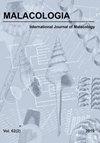亚洲太平洋沿岸血蛤的种群遗传结构:海洋中的距离隔离
IF 0.7
4区 生物学
Q4 ZOOLOGY
引用次数: 32
摘要
血蛤(Tegillarca granosa)广泛分布在印度-太平洋地区的沿海地区,为研究无根海洋软体动物的基因流动提供了极好的机会。本研究采用扩增片段长度多态性(AFLP) DNA标记对5个血蛤种群的遗传结构进行了分析。群体间遗传分化(Gst)和Nei’s遗传距离分别为0.0245 ~ 0.0785和0.0398 ~ 0.1125。AMOVA分析表明,群体内遗传变异占89.09%,群体间遗传变异占10.92%,表明群体间存在较大的基因流动(平均Nm = 7.1853),具有较高的遗传同质性。UPGMA聚类分析结果表明,地理上距离较近的种群聚集在一起,表明距离是隔离的因素,通过Mantel检验,Gst与logit转换的地理距离之间存在显著的正相关关系,并且减少了长轴回归(r = 0.77, p < 0.05)。在亚洲太平洋沿岸观察到的血蛤种群之间明显的距离隔离可能是南海暖流携带的被动幼虫传播和与水产养殖相关的人类活动造成的遗传同质性的结果。本文章由计算机程序翻译,如有差异,请以英文原文为准。
Population Genetic Structure of the Blood Clam, Tegillarca granosa, Along the Pacific Coast of Asia: Isolation by Distance in the Sea
ABSTRACT The blood clam, Tegillarca granosa, is widely distributed along the coasts of the Indo-Pacific region, providing an excellent opportunity to study gene flow in sessile marine mollusks. In the present study, amplified fragment length polymorphism (AFLP) DNA markers were used to analyze the genetic structure of five blood clam populations. Genetic differentiation (Gst) and Nei's genetic distances between population pairs were found to range from 0.0245 to 0.0785 and 0.0398 to 0.1125, respectively. An AMOVA analysis showed that 89.09% of the genetic variation occurred within populations and only 10.92% occurred among populations, indicating a high degree of genetic homogeneity, probably due to considerable gene flow (average Nm = 7.1853) among populations. Cluster analysis using the unweighted pair group method average (UPGMA) showed that geographically closer populations were clustered, suggesting isolation by distance, which was further supported by a significant positive correlation between Gst and logit transformed geographic distance through a Mantel test and reduced major axis regression (r = 0.77, p < 0.05). The evident isolation by distance observed among blood clam populations along the Pacific coast of Asia is likely to be a consequence of both the passive larval dispersal carried by the South China Sea Warm Current and the genetic homogeneity caused by aquaculture-associated human activities.
求助全文
通过发布文献求助,成功后即可免费获取论文全文。
去求助
来源期刊

Malacologia
生物-动物学
CiteScore
2.00
自引率
0.00%
发文量
15
审稿时长
3 months
期刊介绍:
Malacologia publishes papers on all groups of the Mollusca. Malacologia specializes in publishing long papers and monographic treatments. Complete data are especially appreciated. Papers must be of interest to an international readership. Papers in systematics, ecology, population ecology, genetics, molecular genetics, evolution and phylogenetic treatments are especially welcomed. Also welcomed are letters to the editor involving papers published or issues of import to science of the day.
 求助内容:
求助内容: 应助结果提醒方式:
应助结果提醒方式:


